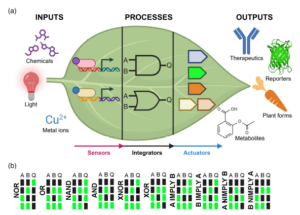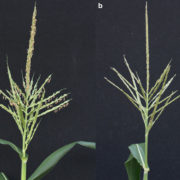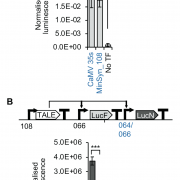Review. Genetic switchboards: Rewiring plant traits with synthetic circuits
 The expression of a transgene in plants can impose a significant stress, sometimes referred to as metabolic burden. Synthetic gene circuits offer a precise approach to engineering plant traits by regulating gene expression through programmable operations. This review by Lloyd et al. examines the core principles and components of these circuits, including sensors, integrators, and actuators. While natural gene regulatory networks have evolved for survival and been further modified by selective breeding, synthetic circuits provide targeted control over gene expression. These circuits function through logical operations (e.g., AND, OR, NOR gates) and require orthogonality, a principle that relies on genetic parts designed to interact strongly with each other while minimizing unintended interactions with other cellular components. The authors outline synthetic gene circuit architecture: sensors detect molecular or environmental inputs via inducible promoters, though stability challenges must be addressed. Integrators process signals using engineered promoters, recombinases, or CRISPR repressors, enabling logic-based regulation. Actuators execute the response, modifying cell function, such as controlling endogenous genes or influencing metabolic pathways. Bacterial allosteric transcription factors (aTFs) offer a promising means of combining sensing of specific metabolites and regulated gene expression but require further optimization to function efficiently in plant systems. A major challenge in plant synthetic biology is the long development time compared to bacteria, where rapid design-build-test-learn (DBTL) cycles enable faster refinement. Transient expression systems can accelerate testing before stable transformation. Other challenges include inefficient gene targeting, lack of standardized DNA delivery methods, and whole-plant regeneration constraints. Advances in computational modeling, high-throughput screening, and targeted transgene integration will be critical for progress. Overcoming these obstacles will unlock new plant traits, improve crop resilience, and enhance fundamental plant research. (Summary by Elisa De Meo) Plant J. 10.1111/tpj.70090.
The expression of a transgene in plants can impose a significant stress, sometimes referred to as metabolic burden. Synthetic gene circuits offer a precise approach to engineering plant traits by regulating gene expression through programmable operations. This review by Lloyd et al. examines the core principles and components of these circuits, including sensors, integrators, and actuators. While natural gene regulatory networks have evolved for survival and been further modified by selective breeding, synthetic circuits provide targeted control over gene expression. These circuits function through logical operations (e.g., AND, OR, NOR gates) and require orthogonality, a principle that relies on genetic parts designed to interact strongly with each other while minimizing unintended interactions with other cellular components. The authors outline synthetic gene circuit architecture: sensors detect molecular or environmental inputs via inducible promoters, though stability challenges must be addressed. Integrators process signals using engineered promoters, recombinases, or CRISPR repressors, enabling logic-based regulation. Actuators execute the response, modifying cell function, such as controlling endogenous genes or influencing metabolic pathways. Bacterial allosteric transcription factors (aTFs) offer a promising means of combining sensing of specific metabolites and regulated gene expression but require further optimization to function efficiently in plant systems. A major challenge in plant synthetic biology is the long development time compared to bacteria, where rapid design-build-test-learn (DBTL) cycles enable faster refinement. Transient expression systems can accelerate testing before stable transformation. Other challenges include inefficient gene targeting, lack of standardized DNA delivery methods, and whole-plant regeneration constraints. Advances in computational modeling, high-throughput screening, and targeted transgene integration will be critical for progress. Overcoming these obstacles will unlock new plant traits, improve crop resilience, and enhance fundamental plant research. (Summary by Elisa De Meo) Plant J. 10.1111/tpj.70090.









